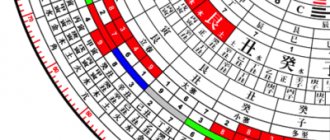It would seem that in the age of advanced technology, no one needs to know how to use a compass; everyone has GPS devices that are more accurate and easier to use. But still, an old, proven device with a magnetic needle is much more reliable, because the navigator can run out of power, break, and also stop working due to a weak signal.
It's easy to get lost in the forest
Without an alternative way to navigate, it’s easy to get lost even in a familiar forest. Man is created in such a way that he has one leading leg (like his arm), and therefore the steps of this leg are longer, while the other leg is shorter, and instead of walking straight, the tourist walks in a circle.
Loss of orientation can also become a problem. If you deviate from the intended path, uncontrollable fear may arise, panic will set in, and it will be difficult to reason logically and make the right decisions. Having a compass, a traveler can easily avoid these dangers.
Compass device
Before you learn how to use a compass, you should understand what parts it consists of and how it works. The main parts of this device are as follows:
- Base body . It usually has a flat and solid bottom, often rectangular, so that it is easy to place flat on the surface, as well as to draw straight lines on the map. Sometimes divisions are applied to the body, like on a ruler.
- A round capsule containing shock-absorbing fluid containing a freely rotating pointer.
- The compass needle is a magnetic strip of metal mounted on a thin axis, almost without friction. One end, which points north, is painted.
- Marking the cardinal directions . It can be applied either to the disc under the arrow or to a special rotating ring around it (bezel). The circle is divided into 360 degrees, on it there are English letter designations for parts of the world: south (S), west (W), east (E), and north (N) is located at the zero mark. The cardinal directions can also be indicated in Russian letters - SYZV.
- Intermediate cardinal directions can often be indicated by letters : northeast (NE or NE), northwest (NW or NW), southeast (SE or SE), southwest (SW or SW).
- On models with a bezel, there is also a direction indicator arrow . When taking a bearing using the compass, you can align it with the magnetic needle or then direct it to a landmark.
- A lock is a small lever that can be used to secure a compass needle.
The so-called tablet compass is mounted on a transparent rectangular base with linear markings, with which you can easily and accurately calculate distances from a map. It is often also equipped with a magnifying glass for examining small details of maps.
The most complex configurations are military orienteering devices, which are more durable and functional. They are distinguished by a one-piece case with a hermetically sealed glass lid and a glow-in-the-dark dial. They can have a built-in clinometer for calculating the inclination of the plane, a thread for attaching to a tripod, and a bubble level.
In addition, there are specialized professional compasses, for example, geological or gyroscopic, which are installed on airplanes and ships. This complex navigation device has the highest stability, works reliably in difficult conditions, and most importantly, it shows not the magnetic pole of the Earth, but the real geographic one.
Answers to questions
Operating principle
The permanent magnets of the device interact with the Earth's magnetic field. The principle of operation of a compass is based on the attraction and repulsion of magnets - the needle and the Earth.
Geographical and magnetic poles
Geographic pole is the point at which the axis of rotation intersects the Earth's surface.
See also: Choosing a compass
Magnetic poles are conventional points on the earth’s surface at which the earth’s magnetic field lines are directed at right angles to the surface.
Buying a compass
First, you need to decide on the specifics of using the device. Before purchasing, check the compass for serviceability and, of course, consult with a specialist.
Specifics of using compasses
The compass should not be operated near objects with electromagnetic radiation.
Mineral deposits or magnetic storms that distort the Earth's field can contribute to the deviation of the magnetic needle.
The user should not move while the device is rotating. Also, you cannot turn the needle artificially, for example, by tilting the compass.
Geographic north and magnetic pole
Those who want to seriously learn how to walk with a compass need to understand several geographical terms. For example, there are three concepts of “north”. “True North” is located at the geographic point of the planet’s pole; it does not play a role in navigation. What is important is the “magnetic north pole”, to which the compass needle reacts, and it is constantly shifting in the Earth’s magnetic field. And the third north is the “conditional north” on the map, unlike the first two, it is not a point, but a line along the entire upper edge of the map.
In addition, there is the concept of “magnetic declination”. This is the angle between the directions to the geographic and magnetic poles of the Earth. If the magnetic pole is shifted to the east from the true one, then the declination is considered positive, if to the west, then negative. The exact declination values at the moment for each point on the globe can be found using special online calculators.
In what cases is a compass better than modern gadgets?
In modern society, the demand for compasses is very low. Modern gadgets are equipped with GPS and location functions and allow you to navigate while moving while projecting the user’s movement.
A significant drawback is the battery, which can run out at any time. The compass has the advantage of not requiring any source of energy to operate.
The compass is especially useful during forays into nature; in the forest, for example, you won’t be able to charge the gadget.
Orientation using a compass does not require any special skills.
See also: Determining cardinal directions without a compass
Navigation by compass
In practice, using a magnetic orientation device is not as difficult as it seems. The following instructions will help you master the skills:
- Determine the landmark in which direction to go and stand facing it.
- Place the compass strictly horizontally on your palm, holding it in front of you at chest level.
- Look where the red end of the arrow is pointing - north is in that direction.
- Turn the compass or turning ring so that this end of the arrow aligns with the zero point of the scale.
- Point the indicator arrow at your landmark and see which way to go. This process is called bearing, or determining azimuth.
Then you can walk in a given direction, periodically repeating this method of orienteering to check.
Why is the astronomical compass not used all the time?
The astronomical compass also not ideal. In rainy weather, when the whole sky is covered with clouds, not a single celestial body is visible - which means that such a compass will turn into a useless toy . But, even despite this, it is actively used by sailors.
And in the city, of course, a compass is not really needed. smartphone with you or just ask someone for directions.
And even in the forest, special compass applications . But it’s better not to rely on them completely - the phone will run out , and then try to get out. In addition, there is some romance in using a compass. You immediately feel like an adventurer.
Use with card
The compass is convenient to use together with a map of the area. It is important that the map displays the entire region where the hike is taking place, preferably with a small margin.
To get directions on the map, you need to do the following:
- Lay the map out on a flat surface, north facing up. Place the device on the top of the tablet, making sure there is nothing metal nearby.
- Draw on the map point A, the location of your current deployment, and point B, which you need to get to, and draw a line between them. Knowing the scale, use a ruler and calculate how many kilometers you plan to walk.
- Rotate the compass marking so that north coincides with north on the map, and position it above the drawn line. Look at the numbers and write down how many degrees the path deviated from the north direction. This will be the azimuth.
Align the arrow indicating the direction with the azimuth, remove the map and set off, holding the compass in front of you.
How to connect a compass app on your phone
A regular compass can be purchased at any sports store. However, it’s even easier to download the required application to your phone. Any operating system is suitable for it. On the latest versions of iPhone, the compass is a standard application.
After starting the program, the compass must be adjusted using rotations and turns, ensuring that the arrow points towards the North. The white arrow will determine the direction the user is looking. It is necessary to ensure that the two arrows coincide. Then the desired direction of movement should be recorded on the phone screen. Then, at the slightest deviation from the course, the compass will report this.
It’s easy to determine the exact location of an object if you synchronize the compass with the maps on your phone. To do this, you need to turn on geolocation mode and click at the bottom of the phone screen. Many smartphones have built-in GPS navigation functionality. It helps to understand in which direction the user is moving and displays this data on a map of the area.
Compass applications can be downloaded to your phone on the Internet. The most popular of them are:
- Accurate compass;
- Smart Compass;
- Compass 360.
Avoiding obstacles
Don't panic when you have to deviate from the set course. If you know how to use a compass correctly, it will help you calmly get around any object and return to your chosen route. You will need to perform the following sequence of actions:
- Stop in front of the obstacle and take another bearing.
- Determine which side is more convenient to get around the obstacle. If the detour is on the right, add 90 degrees to the azimuth; if on the left, then subtract 90 degrees. Let's say the azimuth was 170. Then the new value will be 80 or 260 degrees.
- Move in a new direction, counting the number of steps until the obstacle is completed. Then turn around 180 degrees and walk the same number of steps in the opposite direction to return to your original path.
- Having returned to it, orient yourself again to the cardinal directions on the compass and continue moving along the azimuth corresponding to the figure on the map.
Of course, all these simple techniques require the development of a certain skill. To ensure confident use of the compass when hiking in unfamiliar terrain, you will have to practice several times in familiar terrain.










